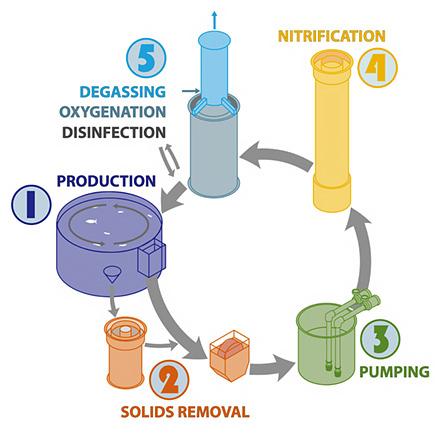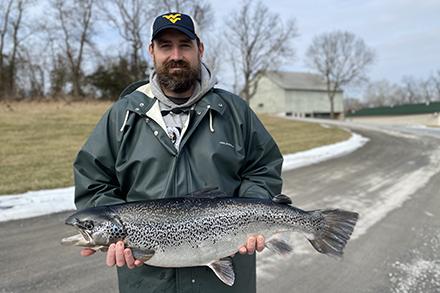Sustainable Fish Farming

Basic process flow and water treatment steps for a recirculating aquaculture system. (Image courtesy of John Davidson, The Conservation Fund Freshwater Institute)
ARS Researchers are Developing Ecofriendly Practices for Atlantic Salmon Production
When choosing food at the supermarket, consumers often focus on the appearance, texture, flavor, and nutritional content. These quality factors are also a priority for food suppliers such as fish farmers, who must balance these priorities with minimizing their environmental impacts of production. The researchers at the Conservation Fund’s Freshwater Institute (TCFFI) in West Virginia are helping fish farmers meet both these goals by employing sustainable fish production practices.
One of the practices at TCFFI is the use of recirculating aquaculture systems, also known as RAS. RAS is a growing technology for farming fish or other aquatic creatures, including Atlantic salmon, because it involves reusing the water in the production cycle. This ultimately allows these systems to be located anywhere, thereby increasing opportunities for local food production.
“The recirculating aquaculture systems are designed so that the water used to rear the fish can exit the system, be treated, capture waste, and then be restored to a quality to where it can be returned to the fish production system,” explained Caird Rexroad III, ARS National Program Leader.
There are multiple benefits to implementing RAS, the most notable being controlling the environment in which fish are raised. Fish farmers can manage the water quality by capturing and removing solid waste and removing compounds that accumulate in the water. Because of the limited use of water, it is simpler and less expensive to remove fish waste rather than drain and refill the system with fresh water.
Although there are many advantages to RAS, experts are researching ways to improve the system. Researchers have observed that some fish reach sexual maturity early, and when they do, their feed efficiency (the amount of feed required to increase the salmon’s weight) is reduced. As a result, it can take more feed to grow fish when they are mature.
“The longer that fish maintain their juvenile growth curve, the better it will be for the efficiency of farming and the better the product for consumers,” said Rexroad.

Freshwater Institute’s Aquaculture Production Manager, Travis May, holding an Atlantic salmon raised and harvested from FI’s recirculating aquaculture systems. (Image courtesy of John Davidson, The Conservation Fund Freshwater Institute)
Early maturation is mostly seen in male fish. Genetics, water temperature, photoperiod – which is the amount of daylight received – and gender affect fish and their reproductive cycle. By controlling these factors, through changes like decreasing water temperature and photoperiod, experts can minimize or eliminate early maturation in RAS.
“For over three decades, we have carried out research to characterize the optimal environment for different salmonid species, such as rainbow trout, and more recently, Atlantic salmon,” said John Davidson, a research scientist at TCFFI. “We're still learning about the optimal conditions and also looking for ways that we can further reduce water use in these systems.”
In addition to early maturation, which affects product quality, researchers are actively investigating how to improve flavor. The taste of the Atlantic salmon can sometimes be perceived as earthy or musty, according to consumers.
“That is something that I've been working on in my area of research for more than a decade,” said Davidson. “We have developed solutions for “off-flavor,” primarily a process called depuration. And now we're also looking at ways to completely avoid and eliminate the problem in the primary fish production system.”
The collaboration between ARS and TCFFI has created an environment for impactful, extensive research on RAS and different aspects of fish production, particularly of Atlantic salmon. Together, researchers hope to assist fish farmers in their management practices while also delivering a high-quality product for consumers. — By Olga Vicente, ARS’s Office of Communications.
You May Also Like:

